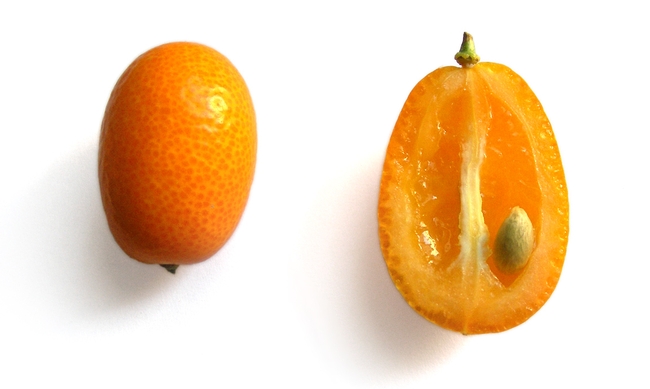Kumquats
The kumquat can be an attractive component of the winter garden with bright green foliage contrasted with multiple orange fruit. Given our recent cold snap, the kumquat is also one of the most frost tolerant citrus available.
Kumquats are evergreen shrubs or trees with dark, glossy, alternate, lanceolate green leaves and sweetly fragrant white blossoms. The fruit are small round or ovoid globes that appear in profusion throughout the tree. The peel is golden-yellow to reddish orange with large conspicuous oil glands; the pulp is segmented and generally contains seeds. Kumquats are slow growing and standard species planted in the garden will grow 8-14 ft. high whereas dwarf and container grown kumquats will reach approximately 6 ft. Kumquats are well adapted to container culture and make beautiful doorway or entry specimens.
Kumquats are native to south Asia and were originally cultivated in China, Japan and throughout southeast Asia. Robert Fortune, a collector for the London Horticultural Society introduced the kumquat to Europe in 1846. Kumquats were originally classified as Citrus japonica but were reclassified as the genus Fortunella in honor of Robert Fortune. The various kumquats are distinguished as species rather than cultivars. There are seven species of kumquats but only three are generally grown in the U.S. Several specialty varieties and hybrid crosses are available in northern California.
The most common species of kumquat grown in northern California are the Nagami kumquat (Fortunella margarita Swing.), the Meiwa kumquat (Fortunella crassiofolia Swing.) and the Fukushu kumquat (Fortunella obovata Swing.).
The Nagami or oval kumquat is the most commonly grown kumquat species in the U.S. and is hardy to 24 oF. It will survive temperatures down to 19 oF with loss of fruit. This species is thornless with heavy yields of ovoid or oblong fruit with 4 or 5 segments of pulp and 2 to 5 seeds. New fruit generally ripens in October to January but will store on the tree much longer. The peel is sweet and pulp sour; the fruit can be eaten if the peel and pulp are chewed together.
The Meiwa or round kumquat is less common in the U.S. and is hardy to 28 oF. The plant is dwarf, frequently thornless or with short, stout spines, and thick, partially folded leaves. The Meiwa yields short-oblong to round fruit with a thick, sweet peel and light orange pulp with relatively low acidity. The Meiwa is considered the best for eating fresh.
The Fukushu kumquat is also less common and although hardy to 28 oF cannot withstand lower temperatures. This species is distinguished by round rather than lanceolate leaves. The bright orange fruit is rounded or bell-shaped and has a thin peel; the pulp is also orange and slightly acidic. The Fukushu is also suitable for eating fresh.
Kumquats are susceptible to most citrus pests and diseases but are generally resistant to citrus canker. The most common pest of kumquats in the home garden are aphids, scale and whitefly; information on management of these pests is available at www.ipm.ucdavis.edu .
Kumquats, like most citrus, are shallow rooted and should be grown in soil with adequate drainage. Kumquats do well in containers. An ideal container should have at least a 15-gallon capacity; wine half-barrels make excellent containers. The container should have multiple holes for drainage and be raised with bricks, wood blocks or ceramic feet to allow adequate drainage and air circulation. Like any container grown plant, soil moisture should be checked often. Regular watering should maintain damp but not wet soil. Container grown kumquats should be fertilized regularly since the frequent watering required to maintain soil moisture will leach nutrients out of the soil.
Most kumquats ripen in late autumn through early winter. The fruit is generally fully colored, usually orange, when approaching ripeness. Taste testing individual fruit will let you know when the fruit are ripe. Since citrus fruit does not ripen well off the tree, kumquat fruit should be left on the tree until harvested. Tree-stored fruit will gradually become darker orange and somewhat sweeter over time.
Kumquats can be eaten fresh although they can be tart. For the adventurous, there is a video on you tube demonstrating how to eat a kumquat http://www.youtube.com/watch?v=GoLr7BieIKQ. Kumquats can be used to make preserves, marmalade and jelly. Thinly sliced kumquats can be used as a colorful garnish or to add zest to a salad.
Kumquats often used as a decoration for the Lunar New Year. Twigs bearing multiple fruit are used as table or gift decoration. Containerized kumquat trees often given as Lunar New Years gifts, especially in Vietnam where the fruit plays a special role in celebrations.
References:
Anzeno, V, March 2008 Citrus for the Home Garden UCANR Cooperative Extension, San Diego //ucanr.edu/blogs/slomggarden/blogfiles/4259.pdf
Ingels, C & McClure, J (eds) Growing Citrus in Sacramento UCANR Cooperative Extension Master Gardener – Garden Notes GN 127 http://ucanr.org/sites/sacmg/files/72239.pdf
Morton, J. 1987. Kumquat. p. 182–185. In: Fruits of warm climates.http://www.hort.purdue.edu/newcrop/morton/kumquat.html
Wikipedia, Kumquat http://en.wikipedia.org/wiki/Kumquat [accessed December 16, 2013.

Kumquat fruit. (photo from Wikipedia.com)


- wondering if there is something wrong?
- do I just wait?
Thanks
Ed
Posted by Ed on March 30, 2020 at 6:26 PM